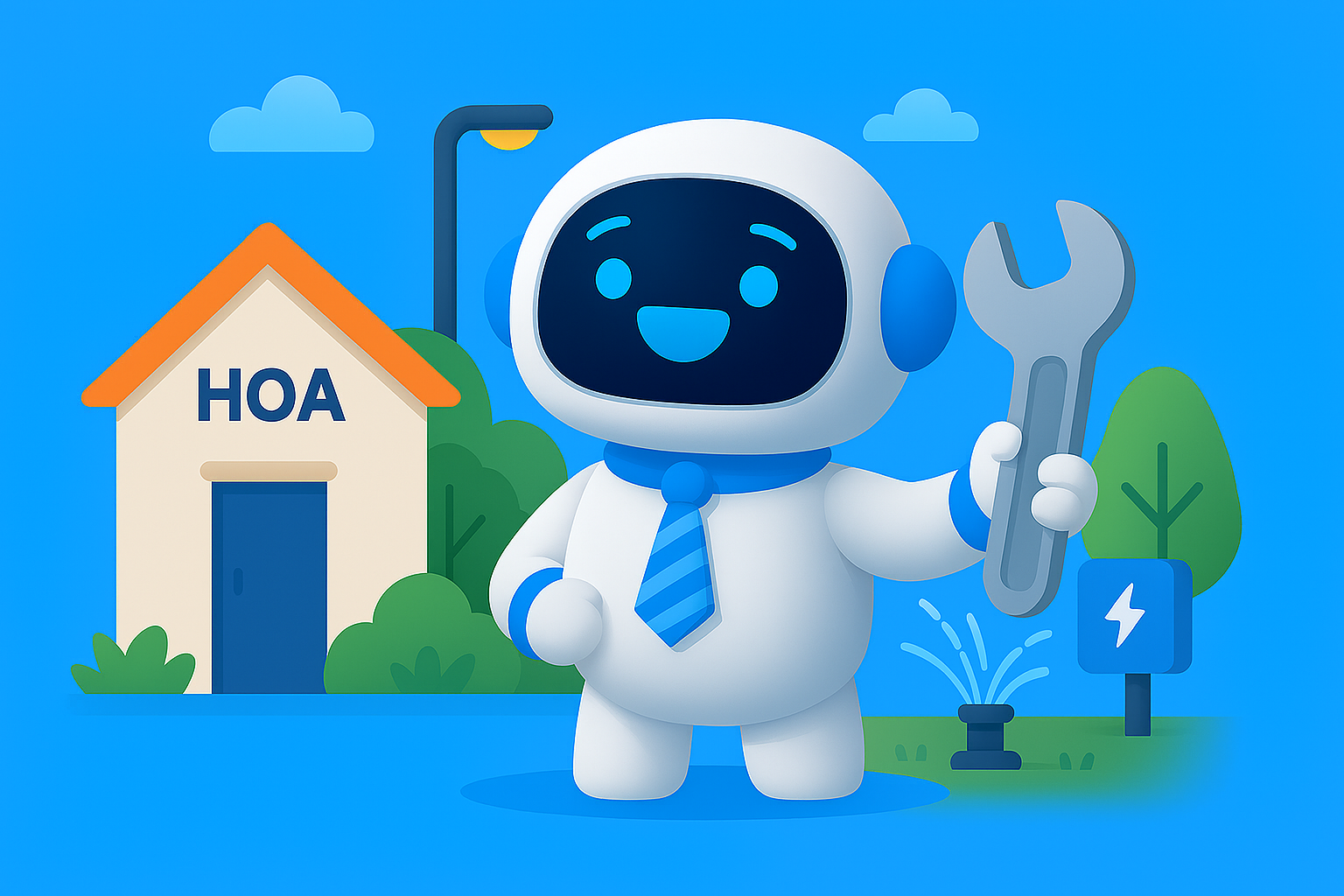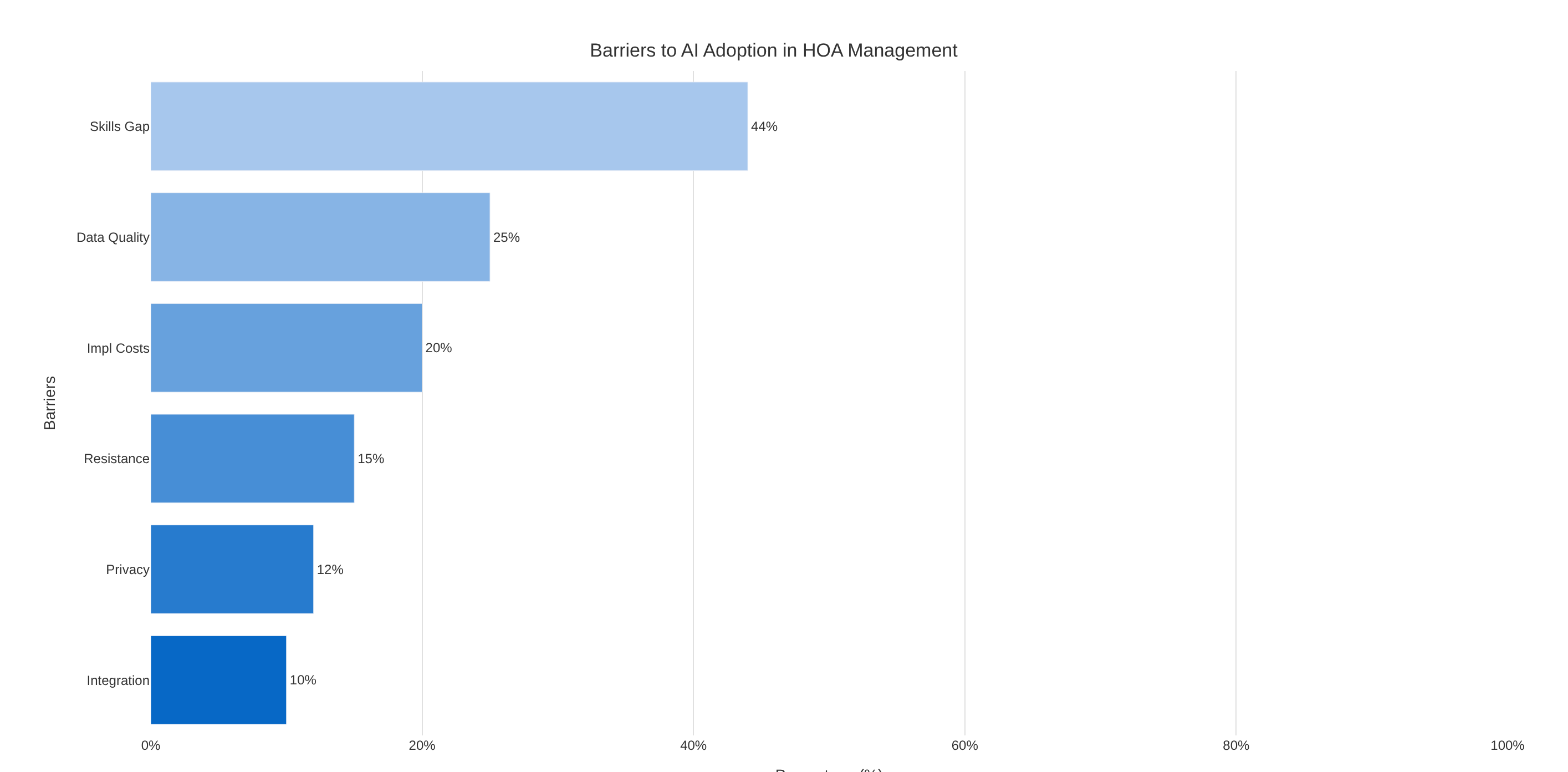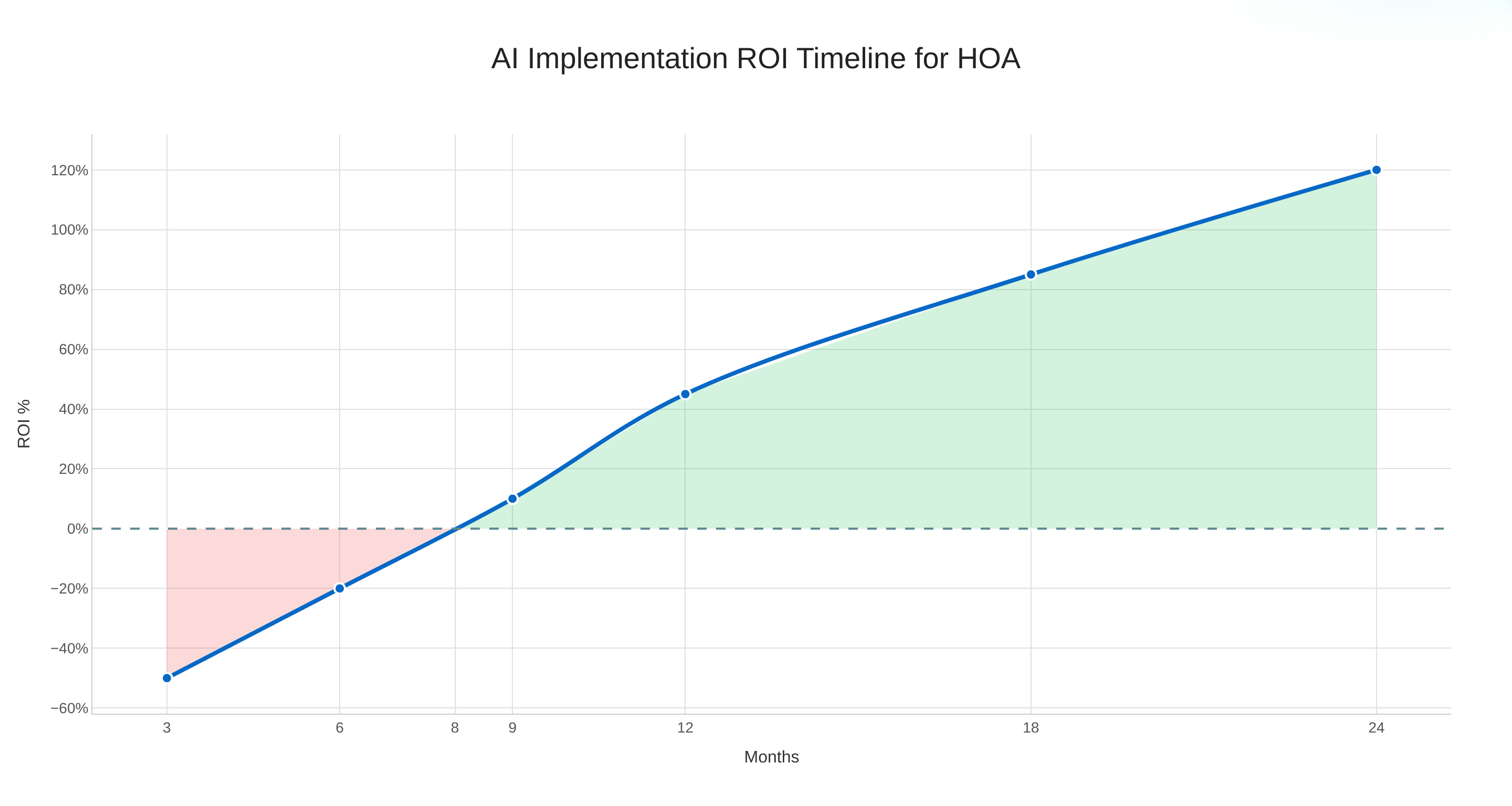
Homeowner associations (HOAs) are increasingly turning to artificial intelligence assistants and agents to revolutionize how they manage common area maintenance. These AI-powered solutions are transforming traditional reactive maintenance approaches into proactive, data-driven operations that deliver significant benefits to both property managers and residents. This comprehensive evaluation examines the multifaceted advantages of implementing AI assistants in HOA common area maintenance, from operational efficiency gains to enhanced resident satisfaction.
AI assistants are delivering substantial operational improvements for HOA common area maintenance through automation and intelligent resource allocation. Property managers report 15-20% reductions in operational expenses through streamlined workflows and reduced manual intervention [1]. The technology enables 40% increases in team productivity by automating routine tasks such as work order processing, vendor coordination, and maintenance scheduling [2].
The efficiency gains extend beyond simple automation. AI systems can handle 90% of routine resident inquiries instantly, eliminating the need for human intervention in common requests about maintenance schedules, facility hours, or service updates [3]. This immediate response capability significantly reduces the administrative burden on property management staff while improving resident satisfaction.
.png)
Energy optimization represents another significant area of cost reduction. AI-powered building management systems can achieve 30% reductions in energy consumption through intelligent HVAC optimization, automated lighting controls, and predictive equipment management [4]. These systems continuously monitor environmental conditions and occupancy patterns to optimize energy usage across common areas including clubhouses, fitness centers, and outdoor lighting systems.
The transition from reactive to predictive maintenance represents perhaps the most transformative benefit of AI assistants in HOA common area maintenance. Traditional maintenance approaches often result in reactive maintenance costing 9-10 times more than preventive maintenance [5]. AI systems address this challenge by analyzing historical maintenance data, equipment performance metrics, and environmental factors to predict potential failures before they occur.
Predictive maintenance capabilities enable HOAs to schedule maintenance activities during optimal windows, minimizing disruption to residents while preventing costly emergency repairs. Equipment such as pool pumps, HVAC systems, and elevator mechanisms can be monitored continuously, with AI algorithms detecting subtle changes in performance that indicate impending failures. This financial impact is substantial. Additionally, the proactive approach extends equipment lifespan by 25-30% [6], reducing long-term capital expenditure requirements for common area infrastructure.
AI assistants excel across multiple domains of common area maintenance, each offering distinct operational advantages. The effectiveness of these applications varies based on implementation complexity and specific HOA requirements.
.png)
Automated Communications represent a cornerstone application, with AI systems managing resident notifications, maintenance updates, and service requests. These systems can send targeted communications about upcoming maintenance activities, facility closures, or emergency procedures, ensuring residents remain informed about common area impacts.
Emergency Response capabilities enable AI systems to detect and respond to urgent situations in real-time. Smart sensors can identify water leaks, fire hazards, or security breaches in common areas, automatically alerting appropriate personnel and initiating response protocols. This rapid response capability minimizes property damage and ensures resident safety.
Energy Management through AI optimization continuously monitors and adjusts building systems for maximum efficiency. Smart thermostats, lighting controls, and HVAC systems work in coordination to maintain comfortable conditions while minimizing energy consumption.
STAN.ai exemplifies the transformative potential of AI assistants in HOA common area maintenance. As the world's first AI-powered assistant specifically designed for property management, STAN.ai has been deployed across over 10,000 communities, serving 1.5 million homeowners. The platform demonstrates how comprehensive AI integration can address the full spectrum of HOA maintenance challenges.
STAN.ai's capabilities extend beyond simple chatbot functionality to include real-time integration with property management software, enabling the system to access current maintenance schedules, work order status, and facility information. This integration allows residents to submit maintenance requests directly through the AI system, which then routes requests to appropriate personnel and provides status updates throughout the resolution process.
The platform's 24/7 availability ensures that maintenance-related inquiries receive immediate attention, regardless of when they occur. This is particularly valuable for common area issues that may arise outside normal business hours, such as pool equipment failures or lighting problems in parking areas.
STAN.ai also provides comprehensive reporting capabilities that help property managers identify maintenance trends, optimize resource allocation, and implement preventive measures. The system can analyze patterns in maintenance requests to identify recurring issues and suggest proactive solutions.
Despite the substantial benefits, HOA adoption of AI assistants faces several implementation challenges that must be addressed for successful deployment.

Skills gaps represent the primary barrier, with 44% of organizations citing lack of AI knowledge as their main implementation challenge [7]. This barrier requires investment in training programs and potentially hiring specialized personnel to manage AI systems effectively.
Data quality issues affect 25% of implementation efforts, as AI systems require accurate, consistent data to function optimally [8]. Many HOAs struggle with fragmented data sources, inconsistent record-keeping, and legacy systems that complicate AI integration.
Implementation costs concern 20% of organizations, particularly smaller HOAs with limited budgets [8]. However, the long-term ROI typically justifies the initial investment, with most organizations seeing positive returns within 12-18 months.
The financial benefits of AI assistant implementation follow a predictable timeline that helps HOAs plan their investment strategy effectively.

The initial implementation period typically involves negative ROI for the first 6-9 months as organizations invest in software licensing, training, and system integration. However, the break-even point typically occurs around month 9 [9], after which benefits begin to outweigh costs significantly.
Substantial positive returns emerge by month 12, with 45% ROI as systems become fully operational and staff become proficient in leveraging AI capabilities. By month 18, ROI reaches 85% as optimization continues and additional use cases are implemented.
Full optimization is typically achieved by month 24, with 120% ROI reflecting the cumulative benefits of reduced operational costs, improved efficiency, and enhanced resident satisfaction. These returns continue to compound over time as AI systems learn and adapt to specific community needs.
The future of AI assistants in HOA common area maintenance promises even greater integration and capability. Internet of Things (IoT) integration will enable more sophisticated monitoring and control of common area systems, with sensors providing real-time data on everything from air quality to equipment performance.
Blockchain technology may revolutionize maintenance record-keeping and vendor management, providing immutable records of maintenance activities and automated smart contracts for service agreements. This technology could enhance transparency and streamline financial transactions related to common area maintenance.
Virtual and augmented reality applications are emerging for maintenance training and remote diagnostics, enabling more effective staff training and expert consultation for complex maintenance issues. These technologies will particularly benefit smaller HOAs that may lack specialized maintenance expertise.
AI assistants and agents represent a transformative opportunity for HOA common area maintenance, delivering measurable benefits across operational efficiency, cost reduction, and resident satisfaction. The technology addresses longstanding challenges in the industry while enabling proactive maintenance approaches that were previously impossible.
The evidence demonstrates that properly implemented AI systems can reduce operational costs by 15-20%, increase team productivity by 40%, and achieve 90% instant response rates for routine inquiries. Predictive maintenance capabilities alone can reduce emergency repairs by 40% while extending equipment lifespan by 25-30%.
While implementation barriers exist, particularly around skills gaps and data quality issues, the ROI timeline shows that most organizations achieve positive returns within 12 months, with substantial benefits continuing to compound over time. Leading solutions like STAN.ai demonstrate the practical viability of comprehensive AI integration across the full spectrum of HOA management functions.
As the technology continues to evolve and mature, HOAs that embrace AI assistants for common area maintenance will be better positioned to deliver superior service to residents while maintaining operational efficiency and financial sustainability. The question for HOA boards and management companies is not whether to adopt AI, but how quickly they can implement these transformative technologies to benefit their communities.
[1] Enhancing Operations with Cutting-Edge Management Technology
https://www.leasey.ai/resources/enhancing-operations-cutting-edge-management-technology/
[2] Automated Tenant Communication and Workload Reduction
https://www.rent.com/
[3] AI for Property Management Operations
https://tomorrowdesk.com/vigilance/real-estate-reboot
[4] AI in Energy Optimization
https://vertenergygroup.com/how-is-ai-revolutionizing-energy-efficiency-in-commercial-buildings/#:~:text=The%20result%20was%20a%2030,foundational%20tool%20in%20energy%20management.
[5] Predictive Maintenance vs. Reactive Maintenance Cost
https://www.comparesoft.com/predictive-maintenance/cost-benefits/
[6] AI-Driven Preventive Maintenance Studies
https://www.researchgate.net/publication/357534123_AI-Driven_Preventive_Maintenance_Studies
[7] AI Skills Gaps in Real Estate Management
https://www.bain.com/insights/ai-skills-gaps-in-real-estate-management/
[8] AI Adoption Challenges and Data Quality Issues
https://www.ibm.com/reports/ai-adoption-challenges-and-data-quality-issues
[9] AI ROI Timeline in Property Management
https://predio.com/blog/ai-roi-timeline-in-property-management
Receive the latest community association technology trends, reports, and data straight to your email.


